Wrington Flood Storage Area (2020)
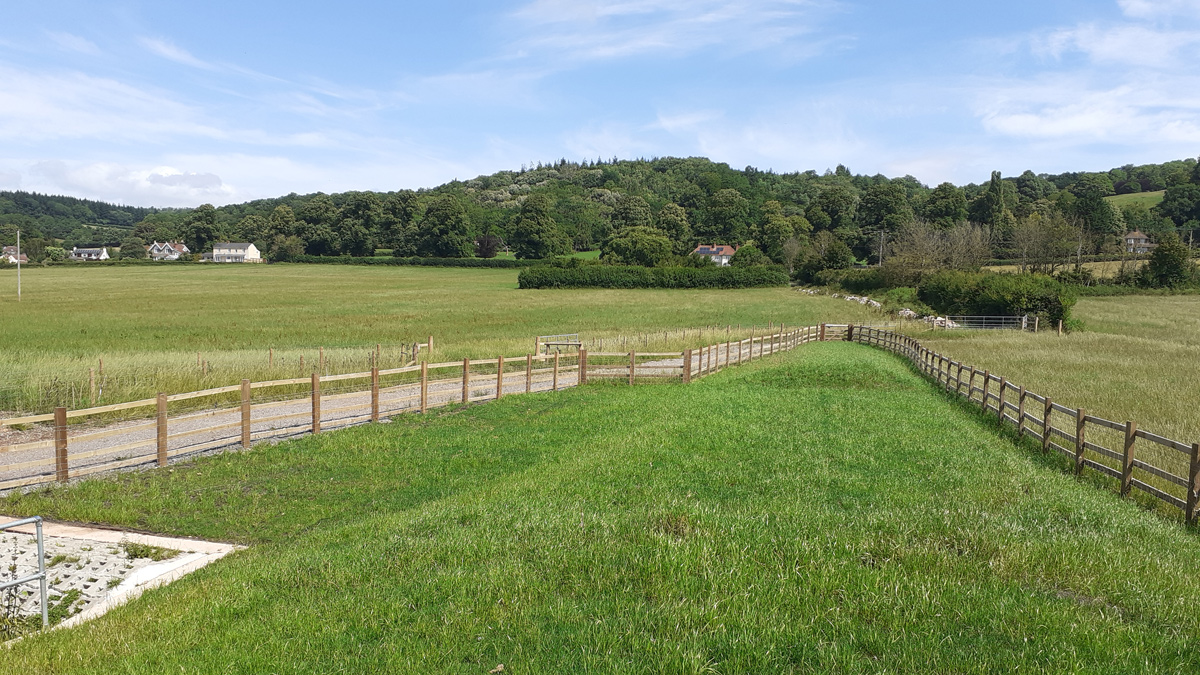
Finished Spillway – Courtesy of North Somerset Council
Wrington village, near the Mendip Hills in north Somerset, lies in the valley of the Congresbury Yeo River, about 20km south-west of the Bristol. Rye Brook flows through Wrington and regularly floods. The floodplain intersects a central corridor through the village, with at least 11 residential properties currently at very significant risk and 42 properties at significant risk. Flooding also affects the main roads into the village. At some locations there is a 1 in 2 chance of flooding in any year affecting people and property. Since 2007-12, six flood events had caused significant flooding and disruption in Wrington with the most severe in 2012 when there was successive flooding in September, November and December. JacksonHyder, a joint venture between Jackson Civil Engineering and Hyder (now Arcadis (UK) Consulting), was appointed by North Somerset Council (NSC) to prepare detailed designs for a flood storage embankment on the Rye Brook above the village under the Environment Agency’s Water & Environmental Management Framework. In operation, the scheme will protect a total of 79 properties.
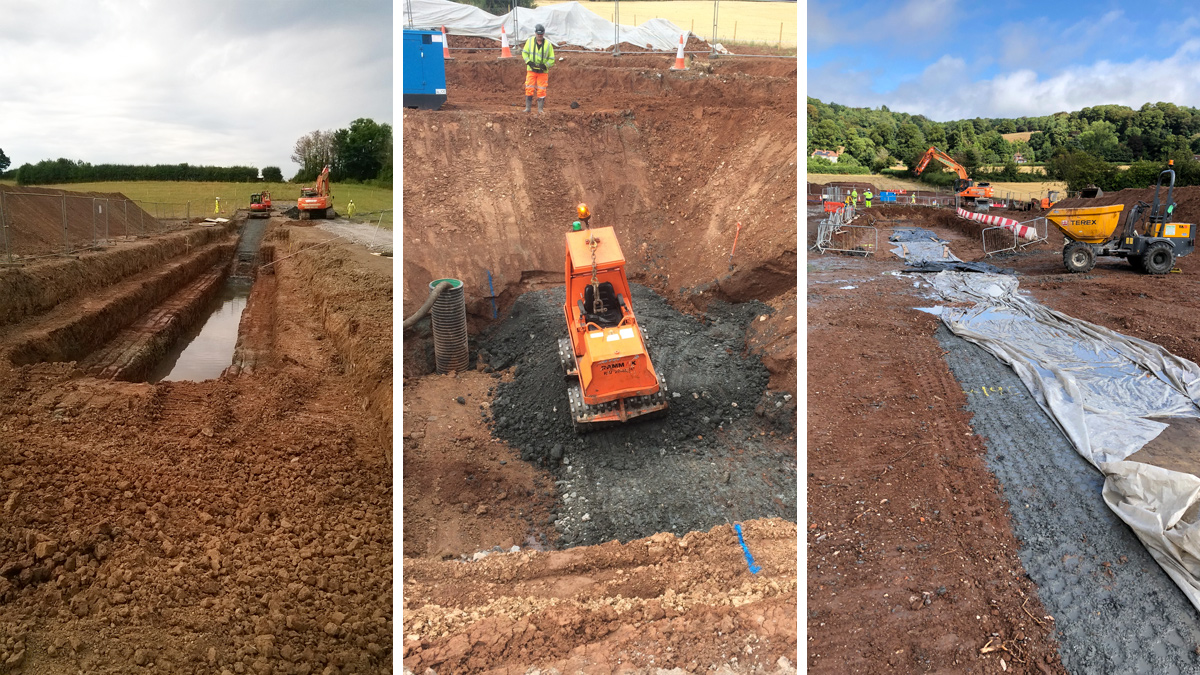
(left) Benched excavation and (middle) core remote compaction – Courtesy of Skanska. (right) Core to formation – Courtesy of Arcadis
Scheme development
The scheme was been developed by NSC, as the lead local flood authority, in partnership with the Environment Agency and Wessex Water. Feedback from consultation on the Scheme options, including numerous public and stakeholder meetings, was positive with support for the preferred option. At the chosen location of the embankment the brook is elevated above the natural valley floor.
Storage embankment location
The 160m long flood storage embankment is located some 300m upstream of Rickyard Road with a crest level set at an elevation of 27.5mAOD and include a 20m long spillway set at 27mAOD thus giving an attenuation volume of 4,600m3. The spillway will become activated for a flood event with a probability of above 2% AEP (1:50-year) and is capable of easily conveying the 0.2% (1:500-year) AEP flows.
JacksonHyder took the original concept design and modified it by changing the position of the spillway so that exceedance flows would rejoin the watercourse rather than discharge to the natural valley floor which would have created further flooding problems. The spillway was designed with a permanent turf reinforcement rather than a concrete block system for better aesthetics.
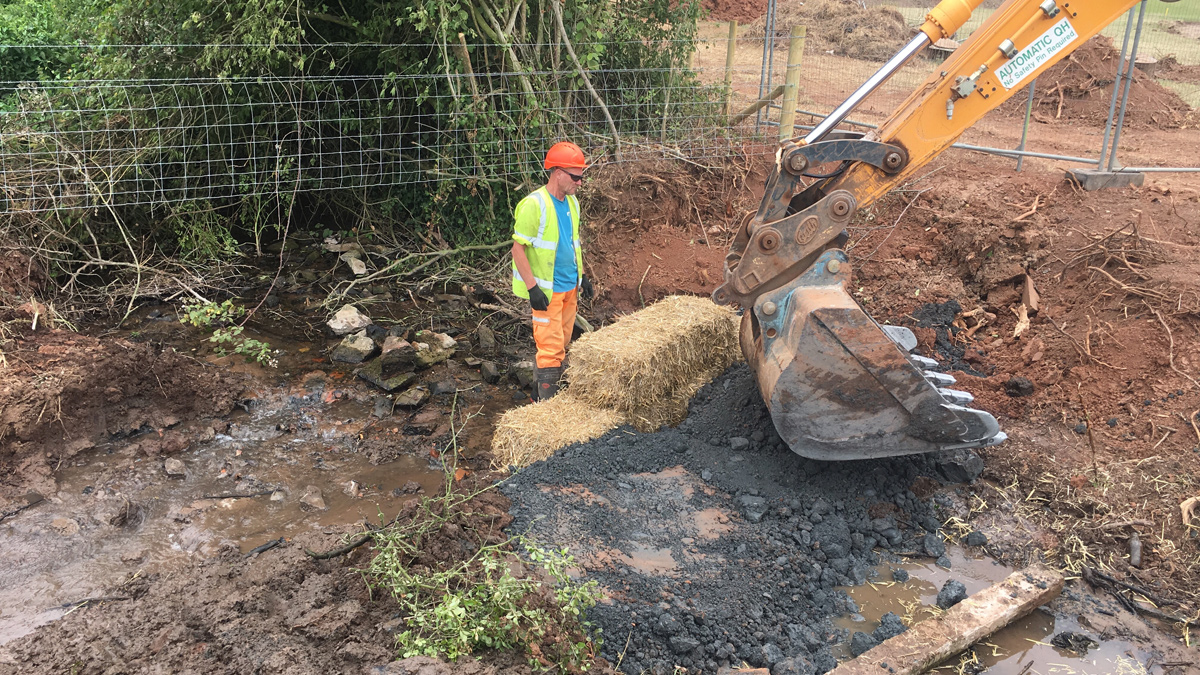
Stream diversion – Courtesy of Arcadis
Wrington Flood Storage Area: Supply chain – key participants
- Client: North Somerset District Council
- Designer: Arcadis Consulting (UK)
- Main contractor: Skanska UK
- Civils sub-contractor: Drayton Construction Ltd
- Fencing sub-contractor: Wyatt & Sons Fencing Ltd
- Penstock: Penstocks (UK) Ltd
- Trash screen & railings: Althon Ltd
- Clay core: Alpha Aggregates
- Type 3 Aggregate: Aggregate Industries
- Concrete: Hopkins Concrete Ltd
- Fencing Hales: Sawmills Ltd
Flood storage embankment
JacksonHyder designed a flood storage embankment capable of reducing the flooding risk to 1 in 50. This includes a 3-stage trash screen and penstock capable of throttling flows to a maximum of 1.4m3/s through a 1000 x 500mm precast concrete culvert during floods with good access for maintenance. This throttling effect is important so as not to overload a culvert running through the village that was upgraded during Phase 1 of the scheme (completed by North Somerset Council).
The embankment has a 2m clay core which is socketed into the existing ground up to a depth of 3.6m to ensure that leakage is minimised. A compaction method was specified to avoid the need to for man-entry into a deep excavation, but Skanska eventually elected to install the core using a traditional benched excavation to get to formation level. Both faces of the embankment were designed with a slope of 1:3. The rear ‘dry’ face uses the excavated arisings from the clay core trench to minimise transport and carbon emissions. The face is founded on 150mm thick coarse sand drainage blanket. The front ‘wet’ face is formed from more granular material to resist the drawdown forces exerted by the rapid drainage of the flood storage embankment after the flood subsides. Both faces are protected with badger-proof mesh and stock-proof fencing to prevent burrowing animals from either forming a failure path through the dam or causing damage to the faces.
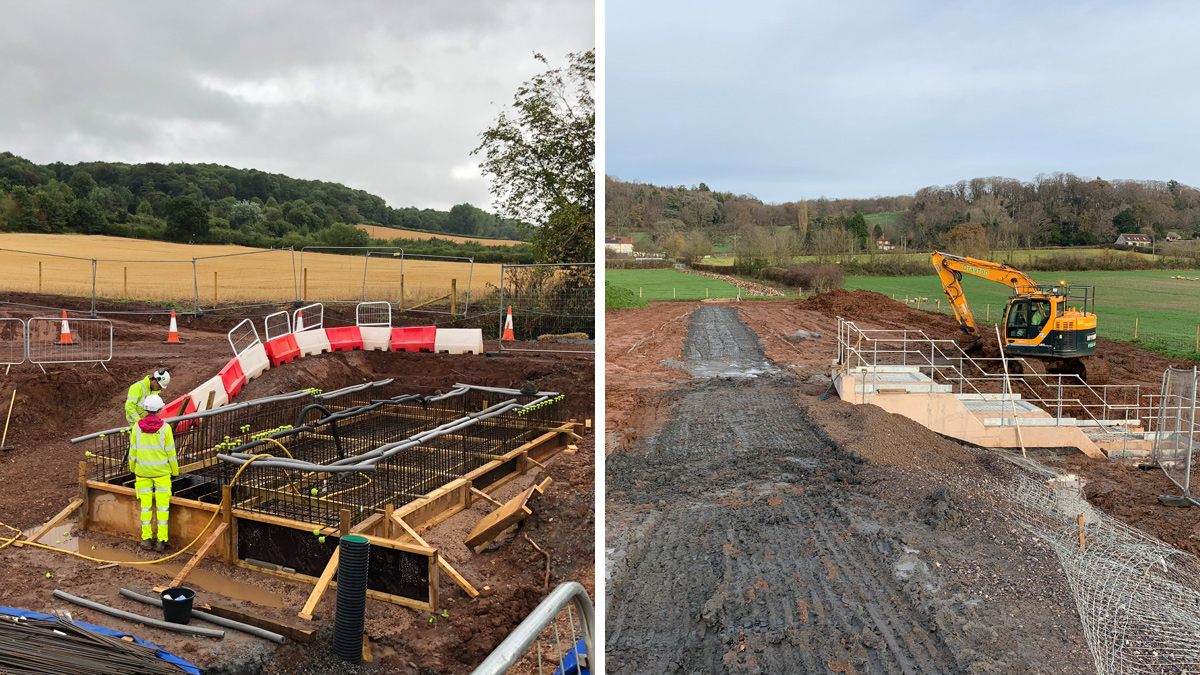
Inlet and core – Courtesy of Skanska
A 225mm diameter vitrified clay sewer ran under the embankment which was replaced with integrally socketed PVCu structured wall type and sealed manhole covers to prevent it from becoming a bypass route under the embankment during filling. A field drain was also blocked off and diverted to flow into the existing watercourse.
The embankment
The embankment is located to allow continued farmer’s access to his fields during flood events and accommodates a footpath over the dam which currently runs alongside the brook. Steps had to be constructed to allow hikers to walk over both faces of the embankment with fencing and gates to prevent them freely roaming over structure. Fencing was also erected at the toe of the dam to prevent cattle from accessing the faces of the embankment since the pressure exerted by cattle through their hooves is enough to cause soil erosion and, in time, the crest level to degrade. Although sheep are acceptable and can help crop the grass which allows for good inspection, the farmer is a cattle farmer and hence the need for the extra protection.
Five metres downstream of the embankment culvert, another slightly larger culvert (1000mm x 750mm) takes the farmer’s access track across Rye Brook. In between the culverts, the brook banks and bed are protected using an ArmorFlex articulated concrete block mattress to allow flows from the spillway to rejoin the brook. The embankment is also designed to blend into the landscape and minimise the effect on the local ecology.
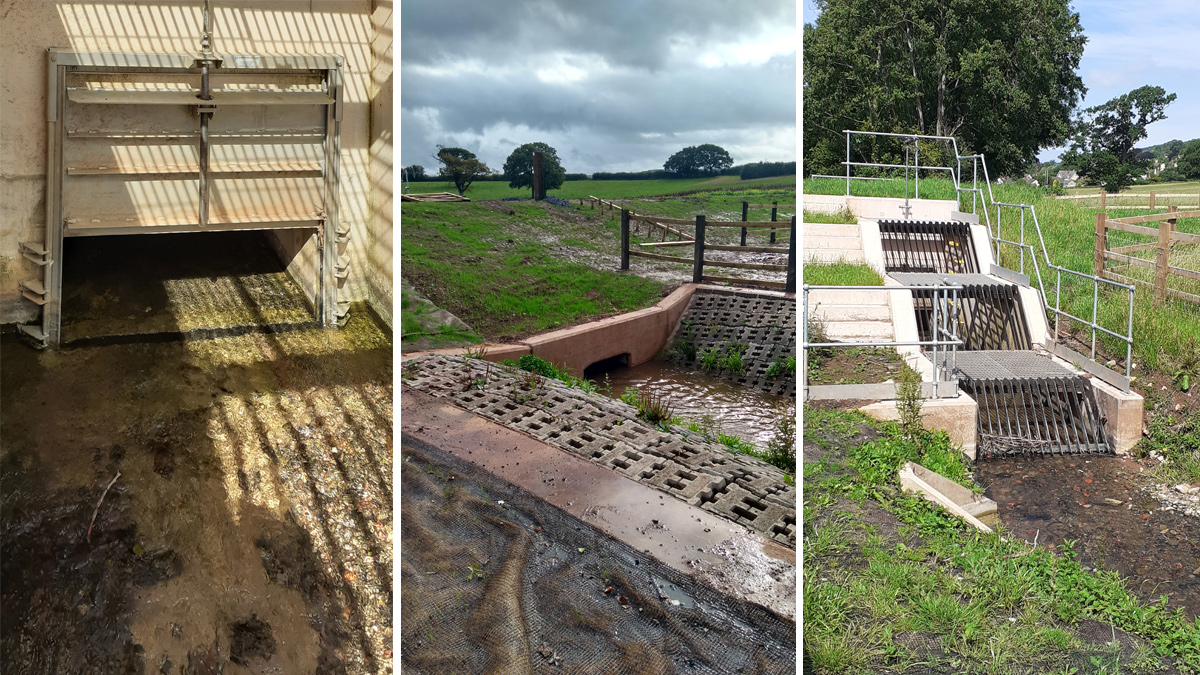
(left) The penstock and (right) trash screen and culvert inlet structure – Courtesy of North Somerset Council, and (middle) ArmorFlex matting – Courtesy of Arcadis.
Ecological surveys
During ecological surveys, dormice were found to be present at the site. This was discovered late on in the season and caused the scheme to be delayed by a year. To protect dormice and maintain connective dormouse habitat throughout the site, JacksonHyder’s dormouse licensed ecologist was employed to design appropriate measures and obtain a European Protected Species Licence to remove parts of the hedgerows on site before commencing work and to supervise translocation of remaining hedgerows post construction.
A badger sett was also identified within a stand of Japanese knotweed (invasive species). Impact on the works was assessed and mitigated so that works could continue uninterrupted. Trees that were required for removal were surveyed to ensure that birds were not disturbed during the nesting season. Trees with bat roosting potential were also identified for retention and protection during the construction works.
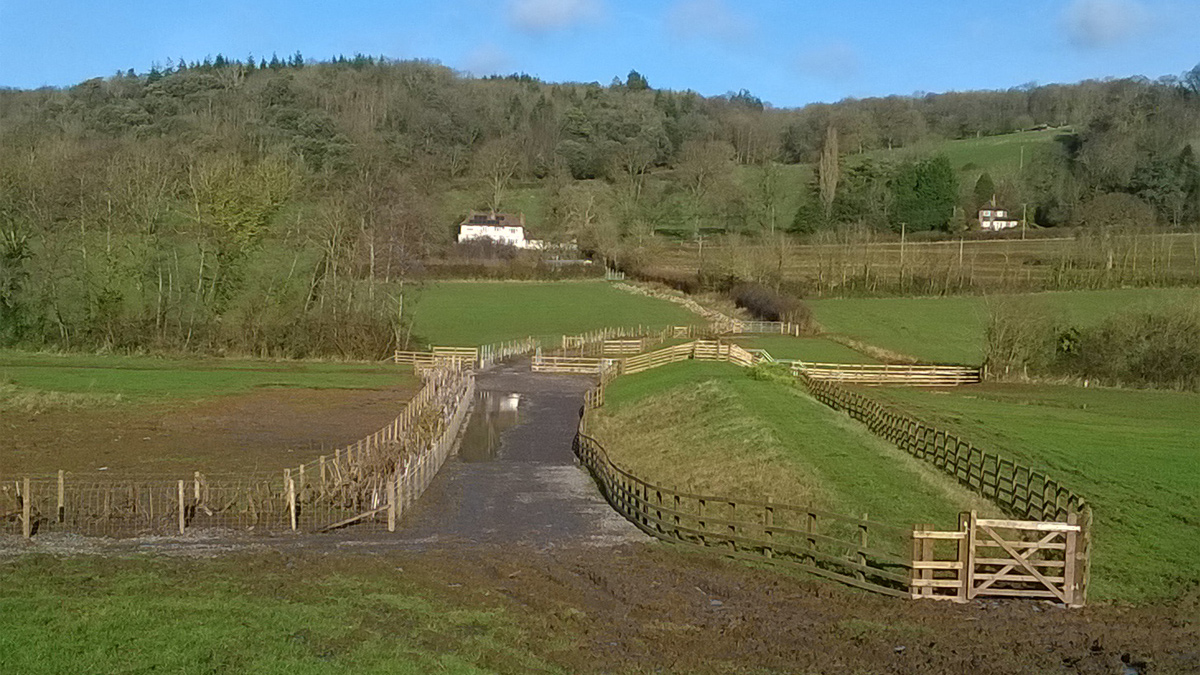
The completed embankment – Courtesy of Arcadis
Completion
The scheme was successfully completed in autumn 2019 in time to prevent the village from excessive flows experienced early in 2020.



